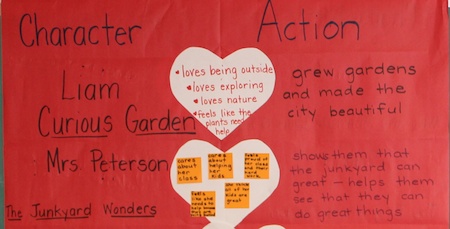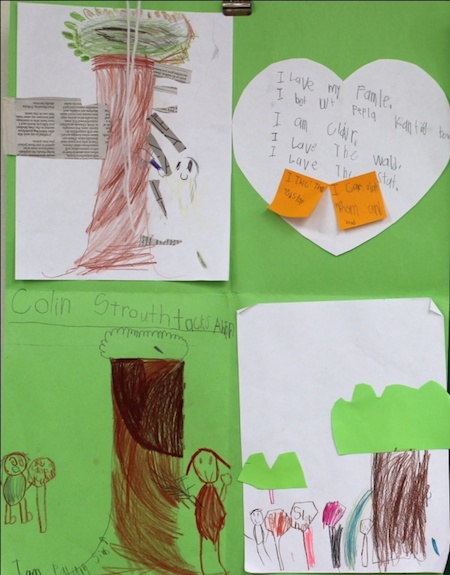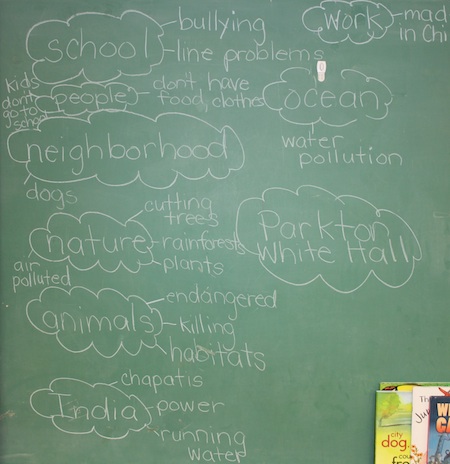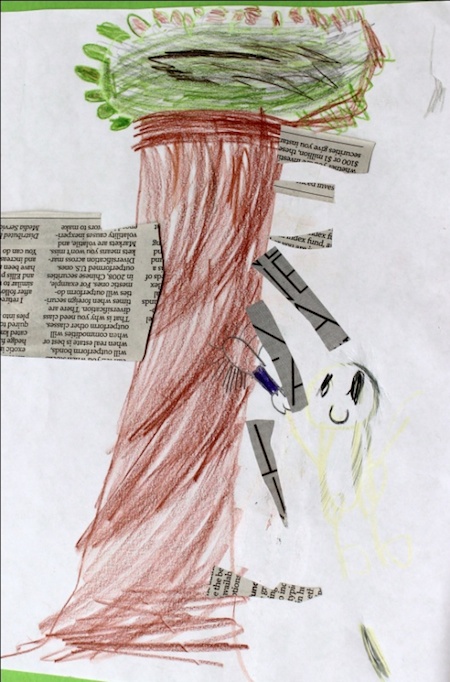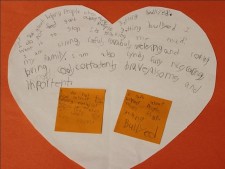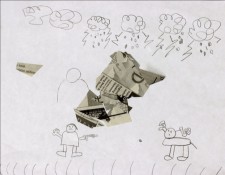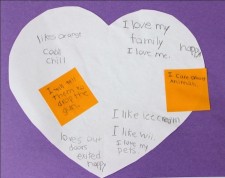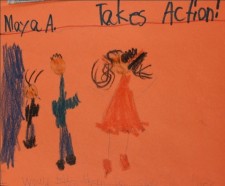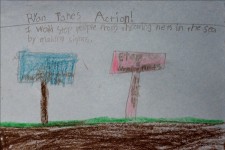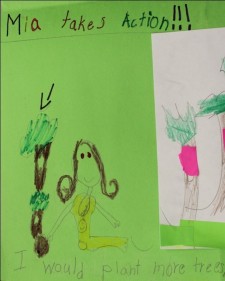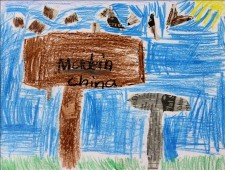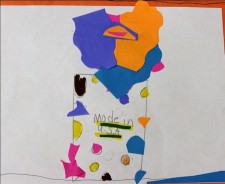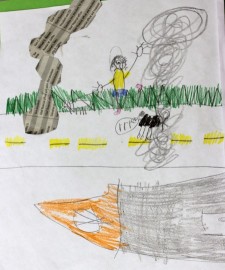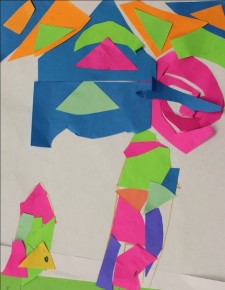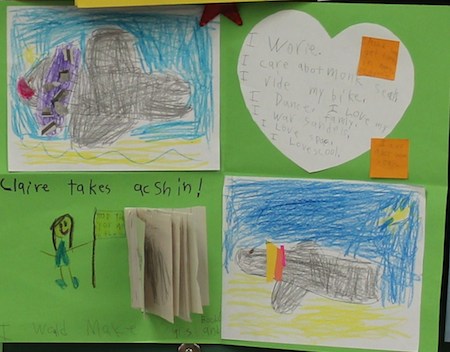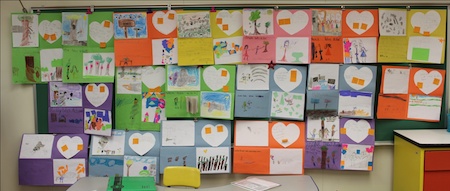“They saw something that wasn’t right and they fixed it.”
by Jenna Loomis
The title of this vignette is a comment by a first grader during a discussion of books in our “taking action” text set. We’d read about 12 books over three weeks and were reflecting and thinking about common themes within the books. Landen’s comment reveals that he understood the characters and the big ideas in our text set. He realized that the characters all saw a problem that somehow touched their hearts and they chose to act. I was excited that Landen and his classmates recognized that the characters in the books took action. That was an excellent start – but my undertaking was to inspire my students to find what touched their hearts enough for them to take action.
My interest in taking action grew out the curriculum framework, A Curriculum that is International (Short, 2009), that our ART Literacy Community has organized our work with global literature around for the past three years. In their vignettes, colleagues in our community described other parts of the curriculum, for example, explorations of cultural identity (Prisca and Ray Martens; Christie Furnari) and cross-cultural studies (Laura Fuhrman; Robbie Stout). Our ART Literacy Community also focused on helping students learn the language of art and how to communicate through art, which is also discussed in other vignettes. In this vignette, I describe my students’ experiences with taking action.
Taking action involves recognizing a problem and assuming responsibility to do something to bring it towards resolution. I wanted our year-end focus on taking action to be a true culmination of our learning, with students using what they learned about themselves, others, and art. My goal was to use a global literature text set of books around issues and problems, our literature discussions, and cultural x-rays of the characters in the books as mentors for students to identify problems they cared about and plan to take action to resolve the problem. In this vignette, I describe our exploration of the characters’ motivations for taking action, the types of action they took, examples of our work together as a class, and how our taking action projects linked our learning across the year.
Moving Through the Text Set with an Eye on Motivation
As I thought about people in our world and characters in books who take action, I realized those who take action have a strong sense of self and a personal connection to the problems with which they choose to engage. For example, in The Curious Garden by Peter Brown (2009), Liam is a boy who loves exploring, nature, and being outdoors, even in his gray and dreary world. When he finds a “lonely patch of color,” a small bunch of wildflowers and plants, the love of nature in his heart connects him to these plants. When he looks closely at them, “it became clear that the plants were dying. They needed a gardener.” The love of nature and the outdoors was within his heart, and he took action.
Reading books from our Taking Action text set became part of our daily read-aloud time. As we discussed the books, and referred to the character x-rays (Short, 2009) we had created earlier in the year, we talked about the traits inside the heart as “what’s in the heart of the character who took action.” Rather than create a complete x-ray for each character, we focused our discussions on the character’s heart and how those elements inspired the character to take action. Students’ understandings of this connection were essential to the culminating taking action project, so to make it visually clear, we created a “heart chart”. Figure 1 shows the two stories at the beginning of our chart.
As a group, we worked together to add the elements on the white heart for the first two stories. Then I divided students into small groups to reread a story and identify what was in those characters’ hearts and the actions they took. The chart in Figure 2 shows a sampling from our Heart Chart.
|
Character and Book |
What Was in the Character’s Heart |
Action |
| Mrs. Peterson in The Junkyard Wonders | •Feels like she needs to help her kids because they are being bullied •Cares about helping her kids •Feels proud of her class and their hard work •Thinks all of her kids are great |
Shows them that the junkyard can be greatHelps them see that they can do great things |
| A child in One Child | •cares about nature •cares about helping the world •loves making a better place •cares about the animals |
She is making the Earth a better place •Picks up trash •Plants a tree •Turns off lights •Writing about the problem •Making signs •Singing |
| Lina and Feroza in Four Feet, Two Sandals | •cares about her friend •she feels bad because she has to get her stuff from a truck |
Gave up her sandals to Lina [at the end] |
| The boy in A Child’s Garden | •lives in a place of ruin •cares for gardens |
When he planted it [cared for the green shoot] it made his ruined place a better place to live |
| Sama in The Forgiveness Garden | •cares about both sides •wanted to stop the fighting •felt the same way as her side (she felt that the people on the other side were like the people on her side) |
Dropped the rockMade a garden for both sides |
Figure 2
Taking Action Ourselves
To make our focus on taking action a true culmination of our year-long learning, I planned for students to identify a problem that spoke to their hearts and identify an action they could take to resolve or improve the problem. Because we were at the end of the school year, there wasn’t time for them to take action before school ended, so I designed a taking action poster with four sections that would allow students to use their knowledge of art, character x-rays, and taking action (see Figure 3). The four sections were: Identifying the Problem through Artwork; Connecting the Students’ Hearts and Their Problems; Taking Action: Identified and Illustrated; Showing “After the Action” Through Artwork.
Section 1 – Identifying the Problem through Artwork
The first section of the poster incorporated artwork depicting a problem that was important to each student. We began with a close reading of the text and illustrations in Sebastian’s Rollerskates (de Deu Prats, 2005). I chose this book as a mentor text for the artwork but my students noted that Sebastian took action. Colin explained, “Sebastian [took action on] something that was his own problem.” At the beginning of the story, Sebastian is shy and cannot express himself to others. In the illustrations, Roviera used newspaper to depict the problem by filling Sebastian’s thought bubbles with gray, dark colors to depict his sadness and frustration with being shy.
As a class we reflected on the books we’d read and journal prompts about problems in school, our classroom and town, as well as our India research to brainstorm a list of problems. Figure 4 shows the problems we identified.
I asked the students to choose a problem that was important to them and create artwork like Roviera’s to show that problem. The students selected and depicted in their artwork a wide range of problems. For example, Reid’s artwork was about the tornados that devastated parts of Oklahoma at the end of the school year (see Figure 5).
Our school had collected school supplies to send to students in affected schools, and Reid had brought in a bag of items to donate. Her artwork was “a bird’s eye view”(as she described it) of the people stuck in the tornado. She used the newspaper to show “stuff that got destroyed…and if it is all destroyed, it is really sad.” She identified A Child’s Garden (Foreman, 2009) as a story that her artwork reminded her of because in that story, the destroyed ruins where the boy lived were in muted, drab colors as was her newspaper.
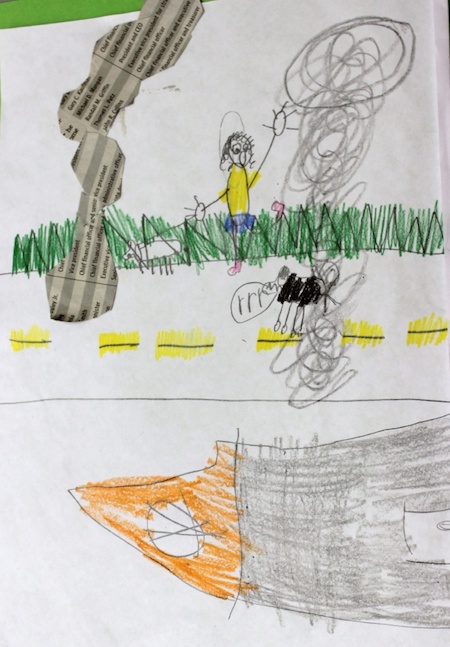 Figure 5 |
Colin identified his problem: “I don’t think it’s good that people cut down trees because it’s taking away all the air and some trees can give you food” (see Figure 6).
Colin spent many hours climbing in trees in his yard, and his mother often had a hard time getting him to come out of trees. He explained his artwork, “I made leaves and some leaves are different colors, because when you cut trees down, leaves get old and start dying…I was trying to make it sad.” The newspaper on the side of the tree is the branches that were being cut.
Section 2 – Connecting the Students’ Hearts and Their Problems
The second section of the poster established why students’ problems were important to them, based on their identities. They created a new heart for themselves based on the elements they had added to two previous personal x-rays. To link what was in their heart to their problem, they attached two sticky notes to their heart, as we did when we created the Heart Chart. Many students had a strong connection between their hearts and the problems they chose for taking action.
Maya’s heart shows the development of her sense of self throughout the year. She includes such descriptions of herself with traits like “strong, loving, cool, confident, brave, awesome, and important” (see Figures 7a & 7b).
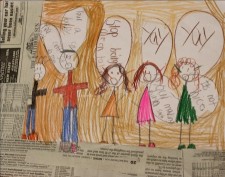 Figure 7a |
When connecting what was in her heart when she thought about taking action with the problem of bullying that she identified, she wrote on her sticky notes, “I do not feel good about people bullying each other because it makes me mad and I want to help them. I care about helping people when they are getting bullied.”
Jonathan wrote that he “loves the outdoors and I love my pet” on his heart (see Figures 8a & 8b). He identified the problem that people were killing animals when they went hunting and he wanted to take action so that those animals wouldn’t be killed.
Section 3 – Taking Action: Identified and Illustrated
Before completing the third section of the poster, we returned to the Heart Chart to review verbs. We went back to the actions the characters had taken and circled the verbs in the Action column to clarify the students’ understandings of what it means to take action. They drew themselves taking action to solve the problem they identified and wrote the action they would take.
Students chose a variety of different ways to take action on their posters. The confident, brave Maya would stand up to the bullies and tell them to stop (see Figure 9).
Ryan, who thinks “it is terrible that dolphins are getting stuck in nets and are dying,” decided to make signs to stop people from throwing nets in the sea (see Figure 10).
Mia’s action was to plant more trees because when trees are cut down, animals lose their habitats (see Figure 11).
Section 4 – Showing “After the Action” Through Artwork
For the last part of their posters, students created another piece of artwork to contrast with their first piece that identified the problem. In Sebastian’s Roller Skates, when Sebastian takes action and gains the confidence to say and do all he wants, the artist Roviera used brightly colored paper for Sebastian’s speech and thoughts to indicate his problem was resolved. Students’ task was to show how their problems might be resolved after they take action to make their world a better place.
Landen’s original artwork identified the problem that too many products we have in the U.S. are being made in China (see Figure 12a). In contrast, his resolution artwork is a tissue box made in the U.S. (see Figure 12b). “It is colorful because it is happy that everything is made in the USA, not like the Made in China picture.”
Reid used the colorful paper to create the sky and the sunset after the tornado had gone, and she filled in the house and the building with colorful paper to show that they had been “fixed up” (see Figures 13a & 13b).
I interviewed some of my students and learned their connections and depth of their understandings. As an example, Claire’s poster (see Figure 14) and her interview are below.
Jenna: What problem did you choose?
Claire: I chose [that] monk seals were getting tangled in nets because monks seals are important to the world and if they keep [being an] endangered species, then that wouldn’t be very good.
Jenna: Why not?
Claire: Because we need animals on Earth because it wouldn’t be a good place to live [without them].
Jenna: How does your illustration show that it’s a problem?
Claire: The monk seal is choking and nobody can help it because it [the net] has been there for a long time and nobody noticed.
Jenna: Tell me about the lines coming from the monk seal’s mouth.
Claire: I did lines that were sound lines that showed that he was choking.
Jenna: What was in your heart when you thought about the problem?
Claire: I added I care about monk seals because I really do. They are my favorite animal.
Jenna: What action did you choose to take?
Claire: I could make a sign and I could march. These are postcards that I made into a book for endangered animals so you can see it is important to save these animals [too]. If you are saving other animals [like the monk seal], they are getting better, but then if you are not saving these animals [the additional animals she pictures on her postcards], they are not getting saved and they are going to die out.
Jenna: Tell me about your artwork that shows what it will look like when the problem is solved.
Claire: A monk seal is going to come on the beach and it has a wound. You can see that this part [with the yellow paper] is almost done healing, this part [with the orange paper] still has a little time. This part [with the red paper] hasn’t been healing but it’s coming up and it will be healed soon. So my sign says “Stop throwing nets into the sea.” That’s no good because they will get stuck and they might drown or hurt the monk seals.
Claire’s interview shows how she connected her personal identity, her concern for other living beings, and art. I was proud of the ways that students connected their learning with their own lives and interests. Figure 15 shows all of their posters. It was an exciting year! The next challenge is to take it one step further –help students put a plan into action.
References
Brown, P. (2009). The curious garden. New York: Little, Brown and Company.
de Deu Prats, J. (2005). Sebastian’s Roller Skates. Illus by F. Rovira. La Jolla, CA: Kane/Miller.
Foreman, M. (2009). A child’s garden: A story of hope. Somerville, MA: Candlewick.
Short, K. (2009). Critically reading the word and the world: Building intercultural understanding
through literature. Bookbird: A Journal of International Children’s Literature, 47(2), 1-10.
Jenna Loomis teaches first grade at Seventh District Elementary School, Parkton, Maryland.
WOW Stories, Volume IV, Issue 7a by Worlds of Words is licensed under a Creative Commons Attribution-NonCommercial-ShareAlike 4.0 International License.
Based on a work at <a href="wowlit.org/on-line-publications/stories/storeisiv7a".

